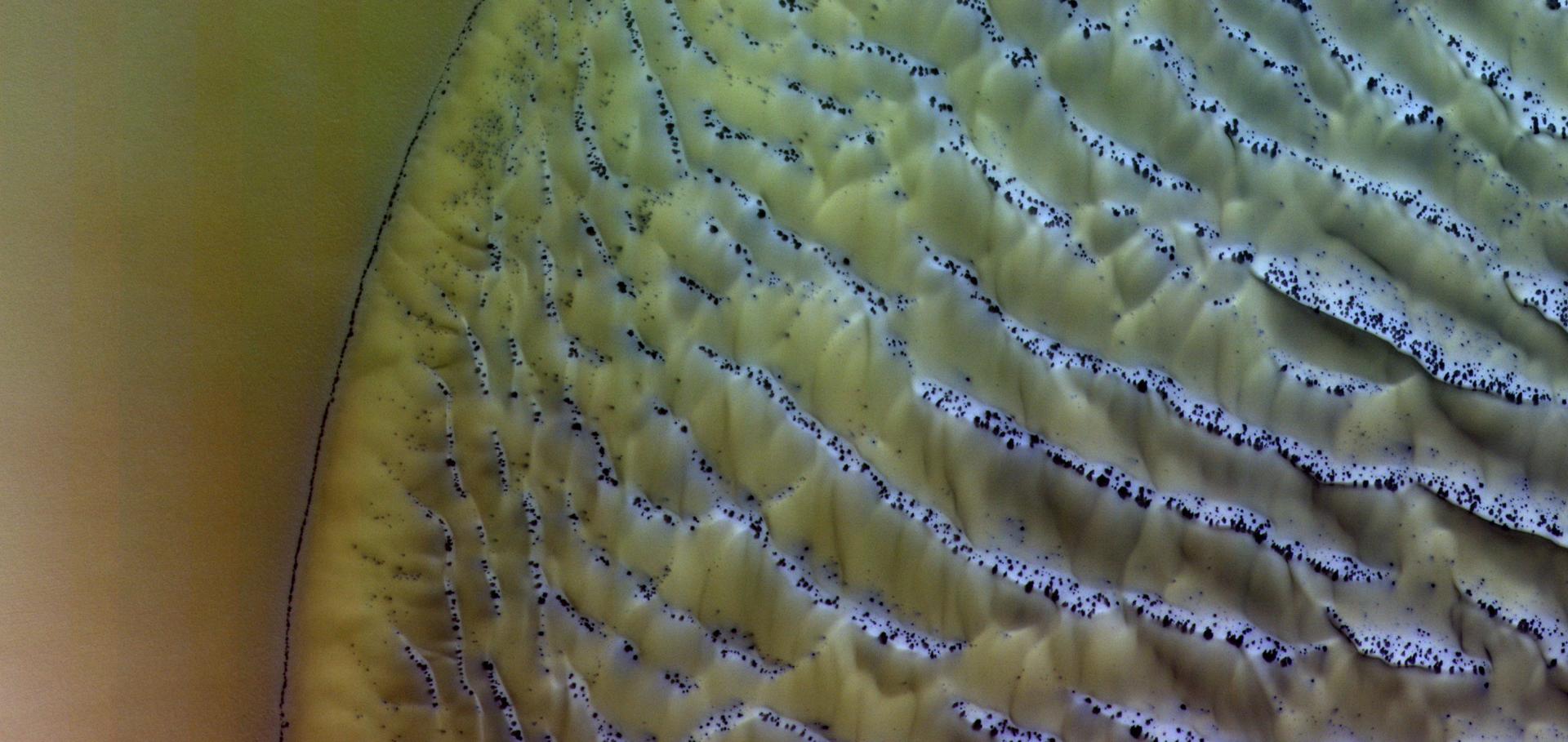A two-Martian years survey of the water vapor saturation state on Mars based on ACS NIR/TGO occultations
Journal of Geophysical Research: Planets American Geophysical Union 128:1 (2022) e2022JE007348
Abstract:
On Mars, condensation is the major factor constraining the vertical distribution of water vapor. Recent measurements of water and temperature profiles showed that water can be strongly supersaturated at and above the level where clouds form during the aphelion and perihelion seasons. Since 2018, the near-infrared spectrometer (NIR) of the Atmospheric Chemistry Suite onboard the Trace Gas Orbiter has measured H2O and temperature profiles using solar occultation in the infrared from below 10 to 100 km of altitude. Here, we provide the first long-term monitoring of the water saturation state. The survey spans 2 Martian years from Ls = 163° of MY34 to Ls = 170° of MY36. We found that water is often supersaturated above aerosol layers. In the aphelion season, the water mixing ratio above 40 km in the mid-to-high latitudes was below 3 ppmv and yet is found to be supersaturated. Around the perihelion, water is also supersaturated above 60 km with a mixing ratio of 30–50 ppmv. Stronger saturation is observed during the dusty season in MY35 compared to what was observed in MY34 during the Global Dust Storm and around the perihelion. Saturation varied between the evening and morning terminators in response to temperature modulation imparted by thermal tides. Although water vapor is more abundant in the evening, colder morning temperatures induce a daily peak of saturation. This data set establishes a new paradigm for water vapor on Mars, revealing that supersaturation is nearly ubiquitous, particularly during the dust season, thereby promoting water escape on an annual average.Global variations in water vapor and saturation state throughout the Mars year 34 Dusty season
Journal of Geophysical Research: Planets Wiley 127:10 (2022) e2022JE007203
Abstract:
To understand the evolving martian water cycle, a global perspective of the combined vertical and horizontal distribution of water is needed in relation to supersaturation and water loss and how it varies spatially and temporally. The global vertical water vapor distribution is investigated through an analysis that unifies water, temperature and dust retrievals from several instruments on multiple spacecraft throughout Mars Year (MY) 34 with a global circulation model. During the dusty season of MY 34, northern polar latitudes are largely absent of water vapor below 20 km with variations above this altitude due to transport from mid-latitudes during a global dust storm, the downwelling branch of circulation during perihelion season and the intense MY 34 southern summer regional dust storm. Evidence is found of supersaturated water vapor breaking into the northern winter polar vortex. Supersaturation above around 60 km is found for most of the time period, with lower altitudes showing more diurnal variation in the saturation state of the atmosphere. Discrete layers of supersaturated water are found across all latitudes. The global dust storm and southern summer regional dust storm forced water vapor at all latitudes in a supersaturated state to 60-90 km where it is more likely to escape from the atmosphere. The reanalysis data set provides a constrained global perspective of the water cycle in which to investigate the horizontal and vertical transport of water throughout the atmosphere, of critical importance to understand how water is exchanged between different reservoirs and escapes the atmosphere.Thermal structure of the middle and upper atmosphere of Mars From ACS/TGO CO2 spectroscopy
Journal of Geophysical Research: Planets American Geophysical Union 127:10 (2022)
Abstract:
Temperature and density in the upper Martian atmosphere, above ∼100 km, are key diagnostic parameters to study processes of the species' escape, investigate the impact of solar activity, model the atmospheric circulation, and plan spacecraft descent or aerobraking maneuvers. In this paper, we report vertical profiling of carbon dioxide (CO2) density and temperature from the Atmospheric Chemistry Suite (ACS) solar occultations onboard the ExoMars Trace Gas Orbiter. A strong CO2 absorption band near 2.7 μm observed by the middle infrared spectrometric channel (ACS MIR) allows the retrieval of the atmospheric thermal structure in an unprecedentedly large altitude range, from 20 to 180 km. We present the latitudinal and seasonal climatology of the thermal structure for 1.5 Martian years (MYs), from the middle of MY 34 to the end of MY 35. The results show the variability of distinct atmospheric layers, such as a mesopause (derived from 70 to 145 km) and homopause, changing from 90 to 100 km at aphelion to 120–130 km at perihelion. Some short-term homopause fluctuations are also observed depending on the dust activity.Climatology of the CO vertical distribution on Mars based on ACS TGO measurements
Journal of Geophysical Research: Planets American Geophysical Union 127:9 (2022) e2022JE007195
Abstract:
Carbon monoxide is a non-condensable gas in the Martian atmosphere produced by the photolysis of CO2. Its abundance responds to the condensation and sublimation of CO2 from the polar caps, resulting in seasonal variations of the CO mixing ratio. ACS onboard the ExoMars Trace Gas Orbiter have measured CO in infrared bands by solar occultation. Here we provide the first long-term monitoring of the CO vertical distribution at the altitude range from 0 to 80 km for 1.5 Martian years from Ls = 163° of MY34 to the end of MY35. We obtained a mean CO mixing ratio of ∼960 ppmv at latitudes from 45°S to 45°N and altitudes below 40 km, mostly consistent with previous observations. We found a strong enrichment of CO near the surface at Ls = 100–200° in high southern latitudes with a layer of 3,000–4,000 ppmv, corresponding to local depletion of CO2. At equinoxes we found an increase of the CO mixing ratio above 50 km to 3,000–4,000 ppmv at high latitudes of both hemispheres explained by the downwelling flux of the Hadley circulation on Mars, which drags the CO enriched air. General circulation models tend to overestimate the intensity of this process, bringing too much CO. The observed minimum of CO in the high and mid-latitudes southern summer atmosphere amounts to 700–750 ppmv, agreeing with nadir measurements. During the global dust storm of MY34, when the H2O abundance peaks, we see less CO than during the calm MY35, suggesting an impact of HOx chemistry on the CO abundance.No detection of SO2, H2S, or OCS in the atmosphere of Mars from the first two Martian years of observations from TGO/ACS
Astronomy and Astrophysics EDP Sciences 658 (2022) A86
Abstract:
Context. The detection of sulphur species in the Martian atmosphere would be a strong indicator of volcanic outgassing from the surface of Mars.Aims. We wish to establish the presence of SO2, H2S, or OCS in the Martian atmosphere or determine upper limits on their concentration in the absence of a detection.
Methods. We perform a comprehensive analysis of solar occultation data from the mid-infrared channel of the Atmospheric Chemistry Suite instrument, on board the ExoMars Trace Gas Orbiter, obtained during Martian years 34 and 35.
Results. For the most optimal sensitivity conditions, we determine 1σ upper limits of SO2 at 20 ppbv, H2S at 15 ppbv, and OCS at 0.4 ppbv; the last value is lower than any previous upper limits imposed on OCS in the literature. We find no evidence of any of these species above a 3σ confidence threshold. We therefore infer that passive volcanic outgassing of SO2 must be below 2 ktons day−1.


